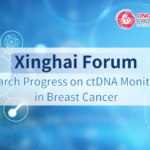
Editor's Note: Circulating tumor DNA (ctDNA) testing allows for continuous dynamic monitoring of tumor genetic variations without relying on tissue samples. This liquid biopsy technology has been widely used in clinical breast cancer research for prognosis and treatment evaluation, but there are still no standards for ctDNA testing, including population selection, testing frequency, and testing methods. At the recent 5th Comprehensive Cancer Treatment Academic Conference of the Dalian Xinghai Medical Forum, Oncology Frontier invited Professor Baoliang Guo from The Second Affiliated Hospital of Harbin Medical University, Professor Guiying Xu from Jilin Cancer Hospital to discuss the application of ctDNA monitoring in breast cancer.Oncology Frontier: ctDNA was a major highlight at this year’s ASCO conference, which featured a special session on the application of ctDNA testing in breast cancer. Professor Baoliang Guo, based on current research progress and clinical experience, can you introduce the main clinical research and practice applications of ctDNA liquid biopsy in breast cancer? Do you prefer to use a large NGS panel or hotspot mutation PCR for ctDNA testing?
Professor Baoliang Guo: ctDNA, as a new liquid biopsy method, has become a hot topic in tumor clinical research due to its non-invasive, rapid, and convenient characteristics. With technological advancements, its clinical applications will undoubtedly become more widespread. In breast cancer, ctDNA can be used for screening in high-risk populations, early detection, and diagnosis. Particularly after breast cancer is identified, baseline ctDNA testing can be used to assess treatment efficacy and patient prognosis based on dynamic changes, especially during the neoadjuvant treatment phase. Some clinical studies have adjusted treatment intensity based on ctDNA changes. In adjuvant therapy, ctDNA can detect early minimal residual disease (MRD), which helps in monitoring treatment efficacy. Ongoing research is examining whether further interventions based on these changes can be beneficial. For advanced breast cancer, early ctDNA detection aids in prognosis assessment and is expected to be widely applied clinically. It can identify target mutations and screen for resistant genes, guiding subsequent personalized treatment.
Regarding the choice between NGS and PCR for testing, both methods have advantages and disadvantages. Optimized PCR methods offer more accurate quantification, although they focus on known single-gene mutations and provide limited information. Their advantages are speed, convenience, and lower cost. NGS covers a broader range of loci, providing comprehensive information on known and unknown genes, with high throughput, sensitivity, and specificity, and more accurate quantification. If conditions permit, NGS testing is preferable. However, in clinical practice, we need to optimize the choice based on the patient’s individual circumstances and disease status.
Oncology Frontier: Professor Guiying Xu, the ASCO conference reported an exploratory analysis of the monarchE study, which analyzed ctDNA in high-risk patients. Could you share the main results and your views on using ctDNA for monitoring and guiding treatment or prognosis assessment in early breast cancer?
Professor Guiying Xu: The monarchE study explored the use of CDK4/6 inhibitors as adjuvant therapy for high-risk early breast cancer patients with HR+/HER2- and lymph node metastasis. The results showed that abemaciclib combined with endocrine therapy significantly improved invasive disease-free survival (iDFS) compared to endocrine therapy alone, with a 5-year iDFS rate benefit of 7.6%. This highlights the importance of CDK4/6 inhibitors in adjuvant therapy for high-risk populations and has led to approval for this indication.
At this year’s ASCO conference, researchers conducted an exploratory analysis of the monarchE study, focusing on the application of ctDNA testing and dynamic monitoring. They performed baseline ctDNA testing on 910 biomarker cohort patients and retested at 3, 6, and 24 months after treatment. The results showed higher iDFS event rates in this cohort (18% vs. 27%), particularly in baseline ctDNA-positive patients, with iDFS event rates as high as 80%, compared to 23% in baseline ctDNA-negative patients (4-year iDFS rates: 20% vs. 79.1%). Patients who remained ctDNA-negative throughout treatment had only a 14% iDFS event rate (4-year iDFS rate: 87.5%). This finding suggests that baseline ctDNA positivity may be a high-risk factor for early breast cancer recurrence and metastasis, potentially predicting relapse. Therefore, ctDNA testing could become an important indicator for early breast cancer monitoring and prognosis assessment.
However, baseline ctDNA positivity was only 8%, and subsequent testing positivity at any time point was only 17%. This indicates that ctDNA positivity detection frequency is relatively low. To broadly apply ctDNA testing for early breast cancer monitoring and prognosis assessment, further clinical studies are needed to verify its accuracy, specificity, and determine suitable populations and testing frequencies. Considering the high cost of ctDNA testing in China and its exclusion from health insurance coverage, its widespread clinical application faces challenges. Further exploration and research are needed to promote ctDNA testing in the breast cancer field.
Additionally, baseline ctDNA-positive patients could turn negative during treatment, with about 40% showing improved outcomes (4-year iDFS rate: 58.3%). This suggests that these patients may benefit from intensified adjuvant therapy. Conversely, patients whose ctDNA turned positive from negative had shorter iDFS (4-year iDFS rate: 11.0%), potentially indicating poorer treatment response and a need for more intensified therapy. As Professor Baoliang Guo mentioned, ctDNA as a new tumor marker has become a current research hotspot and is widely used in clinical practice. Although its potential for monitoring, prognosis assessment, and treatment guidance in early breast cancer requires more clinical research, I believe that “though the road is long, the journey will be accomplished.”

Professor Baoliang Guo
- Chief of the Second Breast Department, Second Affiliated Hospital of Harbin Medical University
- Chief Physician, Professor, Doctoral Supervisor
- Member of the Breast Cancer Committee of the Chinese Society of Clinical Oncology
- Member of the Breast Cancer Professional Committee of the Chinese Anti-Cancer Association
- Standing Member of the Breast Disease Professional Committee of the Chinese Medical Education Association
- Member of the Breast Disease Training Expert Committee of the Chinese Medical Doctor Association
- Member of the MDT Professional Committee of the Surgical Branch of the Chinese Medical Doctor Association
- Chairman of the Youth Committee of the Breast Disease Branch of the Heilongjiang Medical Association

Professor Guiying Xu
- Chief of the Second Breast Department, Jilin Cancer Hospital
- Expert with Outstanding Contributions in the 16th Batch in Jilin Province
- Member of the Breast Cancer Professional Committee of the Chinese Society of Clinical Oncology (CSCO)
- Member of the Breast Cancer Committee of the Second Council of the Oncology Physician Branch of the Chinese Medical Doctor Association
- Member of the First Professional Committee of Tumor Heterogeneity and Personalized Treatment of the Chinese Anti-Cancer Association
- Member of the Professional Committee of Tumor Plastic Surgery of the Chinese Anti-Cancer Association
- Vice Chairman of the Breast Cancer Professional Committee of the Jilin Anti-Cancer Association
- Chairman of the Youth Committee of the Breast Cancer Professional Committee of the Jilin Anti-Cancer Association


